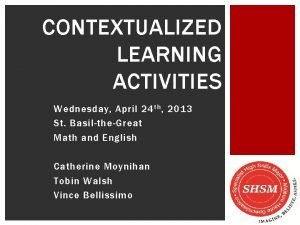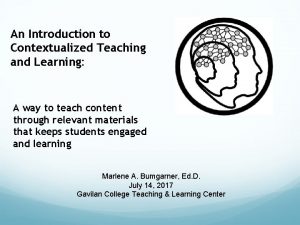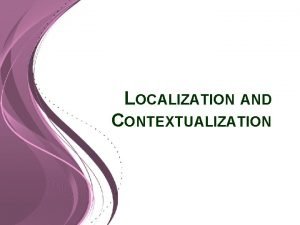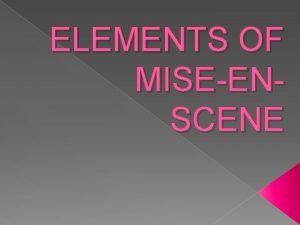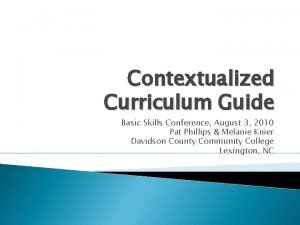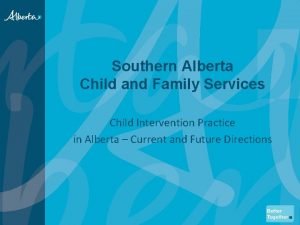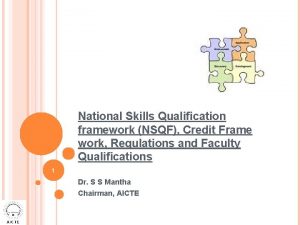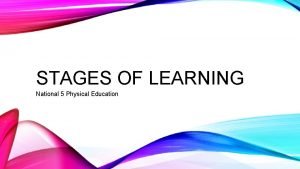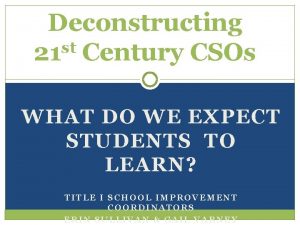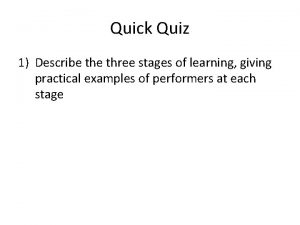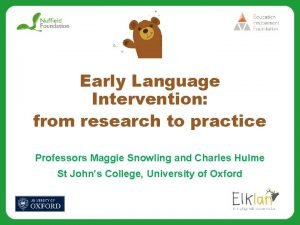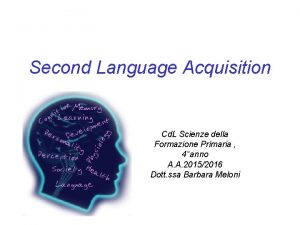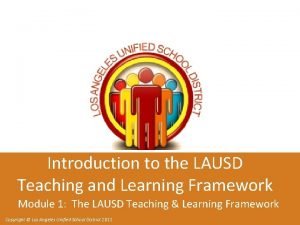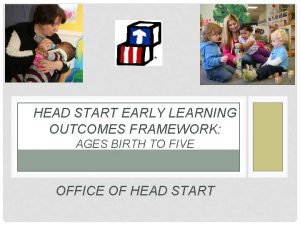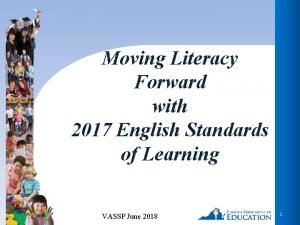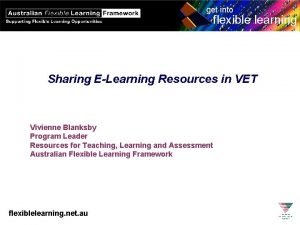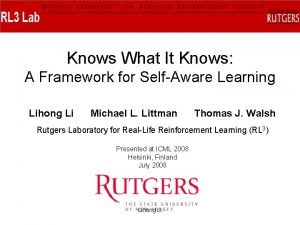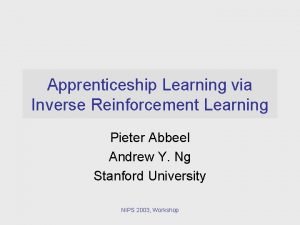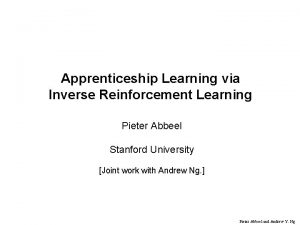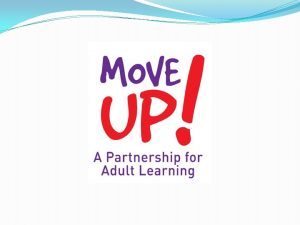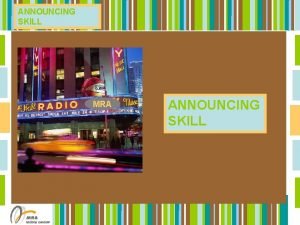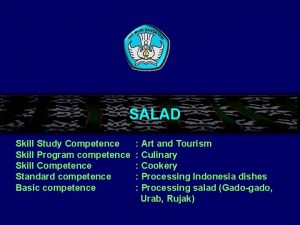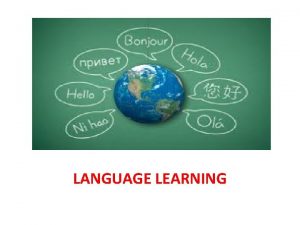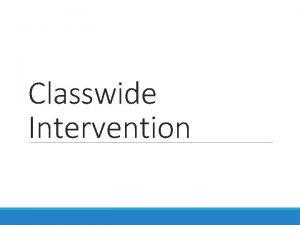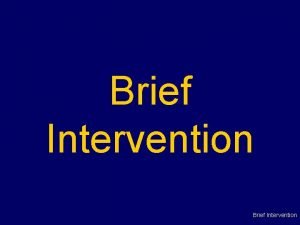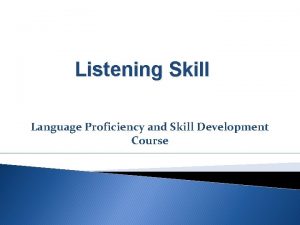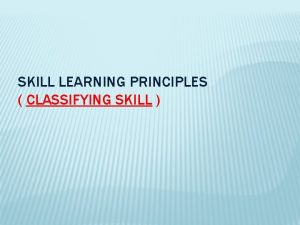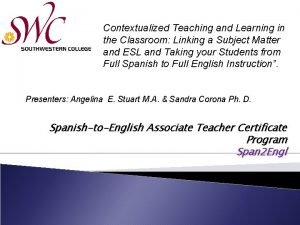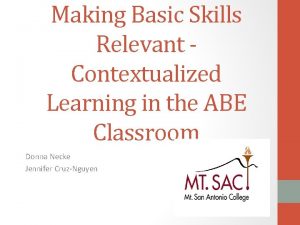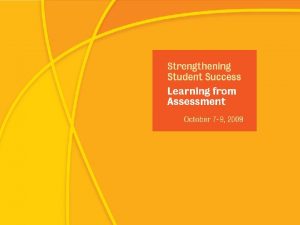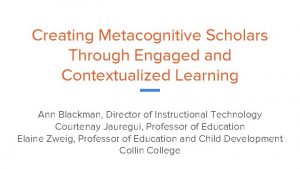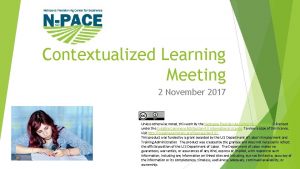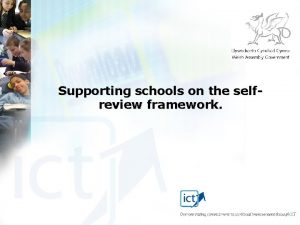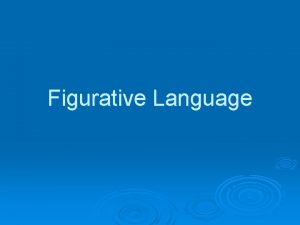CONTEXTUALIZED SKILL INTERVENTION FRAMEWORK Supporting Language Learning in
















































- Slides: 48

CONTEXTUALIZED SKILL INTERVENTION FRAMEWORK Supporting Language Learning in Academic Settings

Power. Point Outline • I. Start with the Game • II. Dynamic Assessment • III. Systematic Learning Supports – A. Structural learning support – B. Interactive learning support • 1. Linguistic Scaffolds • 2. Regulatory Scaffolds • IV. Developing a Growth Mindset (Regulatory Scaffolds)

I. START WITH THE GAME** • In basketball, you have a series of tasks (run, dribble, shoot) • The end goal is to play the game well • Language is the same way—there are skills and strategies, but the end goal is effective communication in social and academic settings and living a productive and happy life

In the old days, you had 2 boxes: ** Whole language— Behaviorist drill and kill, discrete trials, no context, lots of flashcards immerse children in rich literature, but no direct teaching of skills

RISE: ** • Repeated opportunities in an intense schedule with systematic support of explicit learning goals • Active engagement + multiple exposures = success! • Involves mixing whole and part activities along the way

Ukrainetz recommends combining drill and whole context learning—for example: ** • SLP drills on irregular plural cards (this is one mouse—these are 2____) (drill/parts) • Play a game of Go Fish with the cards (whole) • Child drills SLP with cards and tries to catch her doing them incorrectly (drill/parts) • Write/tell a story with the cards (whole)

The SLP and or teacher can do this…

At the risk of beating this point to death….

• Celeste Roseberry youtube channel • Using Drill to Improve Sight Word Recognition

4 th grade science: recycling lesson** • Here are the vocabulary words you will use to work on plural –s: • Wastes, pollutants, plastics, amounts, habitats, beaches • On the index card I give you, pick one of the words above and write how you will work on it in therapy using this paradigm: • 1. parts 2. whole 3. parts 4. whole

For example, with the word “beaches”** • 1. Part—have the child repeat these words after me: beaches, shells, grains of sand, rocks, waves (drill) • 2. Whole—Draw a picture that has all these objects and discuss the picture • 3. Part—Have the child create sentences using each word (e. g. , The shells are pretty. ) [drill] • 4. Whole—Watch a youtube video about conserving our beaches and discuss it afterwards, using the plural –s correctly

II. DYNAMIC ASSESSMENT** • DA evaluates a child’s ability to learn when provided with instruction • We use DA to determine whether a student has an underlying language impairment or is a typical learner with environmental issues • DA can tell us what kind of learning supports work best for each student

Review from 143, not on exam:

III. SYSTEMATIC LEARNING SUPPORTS • A. Structural Learning Support

B. Interactive Learning Support** • 2 types: linguistic and regulatory scaffolds

1. Linguistic scaffolds (p. 94)

2. Regulatory scaffolds** • Aimed at helping the student become a better learner • Includes developing sustained attention, helping her manage challenges

Regulatory scaffolds can include growth mindset work** • This is based on the research of Carol Dweck at Stanford • I have been using it very effectively for the last few years with ages 3 -20

IV. DEVELOPING A GROWTH MINDSET(regulatory scaffolds)

When children are little: ** • High levels of warmth and nurturance from caregivers promote bonding, attachment, and a secure foundation • However, when children reach early adolescence, motivated by a very different kind of nurturance—being challenged to work hard and improve themselves—a growth mindset

The research of Carol Dweck

Those with a growth mindset…** • Believe that intelligence and overall skills can be improved with hard work • Students who believe that they can improve their intelligence and overall performance are more academically successful than those with a fixed mindset

• We have believed for years in a “fixed brain, ”** or that we are born with a certain fixed amount of innate intelligence • Recent findings in neuroscience and cognitive psychology show: the brain has a great deal of plasticity and can be taught, even into older age • (I love the story of a student’s grandma, who began studying Spanish when she was 80!)

In Dweck’s research…** • Conducted a study with low-SES 7 th graders in Texas. Over the school year, each student in the study worked with a college student mentor • Students in the control group heard standard messages about how drugs could interfere with academic achievement

Students in the experimental group…

Again, the experimental students heard that: ** • The brain is like a muscle-- grows stronger with use • Every time you stretch yourself and learn something new, brain forms new connections

In other words…** • Experimental group heard: intelligence is not fixed—it’s malleable, can be ↑with hard work, grit, and perseverance • Good study habits were also taught

The researchers reported that: ** • The image of new connections forming proved extremely motivating to the students in the pilot studies • They reported that as they paid attention in class or studied difficult material, they pictured their neurons growing new connections; and that when they considered not studying, they warned themselves that they would be missing a chance to form new connections

Students were taught that: ** • The brain grows new connections every time we face challenges and learn, and that great mathematicians and scientists are people who have engaged in this process more than other people

We can also explain that it’s like trees growing out to touch each other**

At the end of the year…

The researchers concluded: ** • It is important, particularly if this era of high stakes testing continues, for students to understand that these tests assess current skills and not long-term potential to learn • This is critical since many students make their disappointing achievement test scores as a measure of their fixed, underlying ability and become discouraged about their academic futures

Interestingly, the researchers also found that: ** Students with a fixed mindset are threatened by challenges, effort, and mistakes--these are things threaten to reveal the limits of students’ ability • We portray effortless achievement as the sign of true talent. Many bright students, praised for their easy successes, may believe that they are gifted only when things come easily to them.

We can help students by…** • Teaching them about the new science of brain plasticity and the new view of talent and giftedness as dynamic attributes that can be developed. • Too often, the brain is believed to be static, and talent and giftedness are seen as permanent, unchanging personal attributes that automatically bring later success •

• **Our research (Cimpian, Arce, Markman, & Dweck, 2007; Kamins & Dweck, 1999; Mueller & Dweck, 1998) has shown that giving students praise for their intelligence, as opposed to praise for process (such as effort or strategy) makes students think that their abilities are fixed, makes them avoid challenging tasks (so they can keep on looking intelligent), makes them lose confidence and motivation when the task be-comes hard, impairs their performance on and after difficult problems, and leads them to lie about their scores afterwards.

On the other hand….

Process praise is best:

• **Process praise contributes to much better outcomes than intelligence or product praise • “You are such a hard worker. I’m really excited about how you’re stretching yourself now and working to learn hard things. ” • It may take more time for you to catch on to this and be comfortable with this material, but you if you keep at it like this you will. ”

I never say:


Examples of what to say: ** • “Let’s go around and have each of you share something hard you learned today that you didn’t know before. ” • “Who had a good struggle? Let’s share what we struggled with today” • “Get ready for a terrific struggle! Are you ready? Here we go. ” • “That was a lot of hard work. Can you just imagine all the connections you grew today? ” • “Who thinks they made a really interesting mistake? ” • “Who else made a terrific mistake that will help us learn? ”

Me with a defiant (and huge!) 15 -year old with Fetal Alcohol Syndrome and a history of violence: ** • Dr. R. : “Kiree, I want you to do 50 productions of sentences with slow, careful speech. ” • Kiree: “No way. I can’t. ” • Dr. R. : (after the hour was up): “Just so you know, you did 120 good productions. You didn’t even think you could do 50! Look at you! “

Recent research concludes:

A new study cautions that too much screen time can decrease students’ grit and perseverance** • Pressman, R. M. , Owens, • J. A. , Evans, & Nemon, M. L. (2014). The American Journal of Family Therapy, 42 (5), 347 -363. • “Examining the interface of family and personal traits, media, and academic imperatives using the learning habit study. ” They studied family routines in 46, 000 U. S. homes of children in grades K -12 via an online survey.

Major findings:


Power. Point Outline • I. Start with the Game • II. Dynamic Assessment • III. Systematic Learning Supports – A. Structural learning support – B. Interactive learning support • 1. Linguistic Scaffolds • 2. Regulatory Scaffolds • IV. Developing a Growth Mindset (Regulatory Scaffolds)

If we have time…. ** • The 74 explains how to teach your baby grit • Youtube video • 13 -month old babies tried harder on a difficult task if they saw an adult struggle and persevere on a hard task!
 Contextualized learning activities
Contextualized learning activities Contextualized learning
Contextualized learning Ways to contextualize the module
Ways to contextualize the module Soft skills definition
Soft skills definition Festina lente pronunciation
Festina lente pronunciation Curriculum shall be contextualized and global
Curriculum shall be contextualized and global Contextualized and decontextualized assessment
Contextualized and decontextualized assessment Mise en scene elements
Mise en scene elements Contextualized curriculum
Contextualized curriculum Southeast cfs
Southeast cfs Level-6 of national skill qualification framework
Level-6 of national skill qualification framework Cuadro comparativo e-learning y b-learning
Cuadro comparativo e-learning y b-learning The first stage in the learning of a new skill is ?
The first stage in the learning of a new skill is ? Learning targets knowledge, reasoning, skill product
Learning targets knowledge, reasoning, skill product Describe the three stages of skill learning
Describe the three stages of skill learning Nuffield early language intervention programme
Nuffield early language intervention programme Krashen's monitor model
Krashen's monitor model Language learning with youtube
Language learning with youtube Dispositional framework vs regulatory framework
Dispositional framework vs regulatory framework Example of theoretical and conceptual framework
Example of theoretical and conceptual framework Conceptual framework example
Conceptual framework example Theoretical framework
Theoretical framework Dispositional framework vs regulatory framework
Dispositional framework vs regulatory framework Theoretical framework
Theoretical framework Learning outcome example
Learning outcome example Lausd teaching and learning framework
Lausd teaching and learning framework Headstart early learning outcomes framework
Headstart early learning outcomes framework Eylf meaning
Eylf meaning 2017 english standards of learning curriculum framework
2017 english standards of learning curriculum framework Australian flexible learning toolbox
Australian flexible learning toolbox Hcsw
Hcsw Learning outcomes framework
Learning outcomes framework Example of self enumeration
Example of self enumeration Supervised learning dan unsupervised learning
Supervised learning dan unsupervised learning Concept learning task in machine learning
Concept learning task in machine learning Analytical learning in machine learning
Analytical learning in machine learning Non associative learning definition
Non associative learning definition Lazy learning vs eager learning
Lazy learning vs eager learning Define conceptual learning
Define conceptual learning Analytical learning vs inductive learning
Analytical learning vs inductive learning Apprenticeship learning via inverse reinforcement learning
Apprenticeship learning via inverse reinforcement learning Apprenticeship learning via inverse reinforcement learning
Apprenticeship learning via inverse reinforcement learning Inductive v deductive reasoning
Inductive v deductive reasoning Pac learning model in machine learning
Pac learning model in machine learning Supervised data mining
Supervised data mining Machine learning t mitchell
Machine learning t mitchell Inductive and analytical learning
Inductive and analytical learning Instance based learning in machine learning
Instance based learning in machine learning Inductive learning machine learning
Inductive learning machine learning
